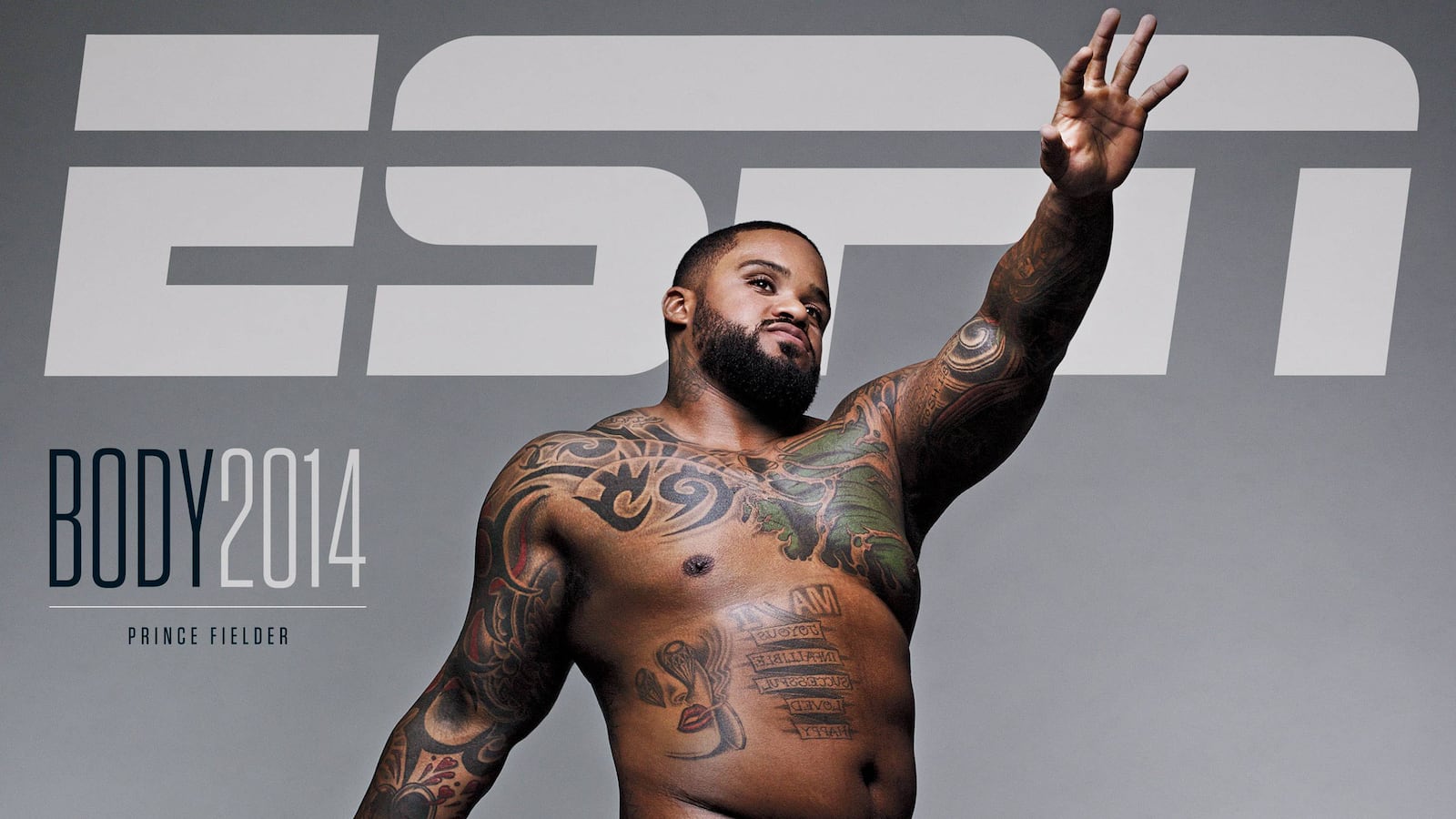Because the Western world is so absurdly, collectively body-dysmorphic anyway, the controversy, the memes, the Internet chatter, after the publication of ESPN The Magazine’s 2014 Body Issue wasn’t about the supremely chiseled, muscled athletes on display but about Prince Fielder, the Texas Rangers first baseman, posing with a bat as proudly as Demi Moore did with her baby bump on the cover of Vanity Fair in August 1991.

Fielder’s naked body doesn’t come with a six-pack. It doesn’t go in and out in the 2014-encoded “right” places. It is 275 pounds of blooming athleticism, but not the kind that is fetishized by Men’s Health. As Fielder said to ESPN: “A lot of people probably think I’m not athletic or don’t even try to work out or whatever, but I do. Just because you’re big doesn’t mean you can’t be an athlete. And just because you work out doesn’t mean you’re going to have a 12-pack. I work out to make sure I can do my job to the best of my ability. Other than that, I’m not going up there trying to be a fitness model.”

Maybe these words of cool, clear sense can somehow be disseminated to all those boys and men chugging odd powders and livid-colored liquids, and eating the world’s reserves of chicken, to supplement their workouts. Fielder is not only right, he also skewers the wider cult of the male body beautiful, which has become the same lunatic mix of aspiration meets oppression as the supermodel body, the waif body, the Kate Moss body, the Victoria’s Secret underwear body—all of those modern template bodies—became for women.
If equality between the sexes still proves elusive, at least we can be said to be gaining parity in becoming ever more anxious about the “right” shape of our bodies. Swimsuit season is now as much of a nightmare minefield for men as it is for women. So thank you, Mr. Fielder, for the bracing reminder that great bodies, handsome bodies, striking bodies, don’t come just in gym-bunny size. Models like the intelligent and articulate Robyn Lawley--defined as “plus-size” when “regular size” would be more accurate--serve as the same vital reminder for women. Both she and Fielder have impressive bodies, by any definition. Mark Simpson, the author who perceptively defined and described “sporno,” the intersection of where sport meets porn in 2006, wrote to me via email of the ESPN picture of Fielder: “That image puts me in mind of this one of Hercules. Not entirely sure that his body is ‘real’--or that's to say any less hyperreal than some of the spornos. It’s just considerably less ripped. It wouldn’t have made the cover of ESPN if it looked ‘civilian.’ Or ‘normal.’ And some of those classical sculptures of Hercules/Heracles didn’t always show him exactly shredded.”
Of course, Fielder is only one out of six models for ESPN The Magazine’s Body Issue, which while apparently celebrating athleticism is really about the exhibition of full-on sporno. Athletes today know that their bodies are on display as much as their sporting abilities; the really sexy, like David Beckham and Cristiano Ronaldo, make money modeling. There are calendars of the sexiest sport stars, they sell underwear and clothes; a lot of their sexiness emanates from their ease with their own hot bodies. A marker of social evolution comes with the display of these sultry images, too: Beckham has posed for the cover of English gay magazine Attitude and warmly acknowledged his body being admired and lusted over by gay men. French rugby players provided similar knowing delight in their Dieux du Stade calendars.
As these calendars and the ESPN Body Issue show, while image isn’t everything, images remain powerful. That there is a “body issue” shows just how much image, indeed sporno unbound, now rules in the lucrative world of sport. Of the other five photographs—of Jamie Anderson, Marshawn Lynch, Michael Phelps, Serge Ibaka, and Venus Williams—featured on ESPN’s magazine covers for this current issue, while they are all indubitably sporno, they are innocent sporno, the chaste sporno if you like, with athleticism emphasized above sex. The emphasis is on fresh faces and tensed bodies and muscles, rather than come-to-bed eyes, pouting, and bulges down below. These “naked” stars are tastefully displayed without genitalia visible or even alluded to with a wink: Our concept of “naked” still, even in 2014, comes with mass-market prudery.
Most intriguing, it is the male bodies that are shot at their most exposed. Anderson is covering her breasts, water spritzing at her face, Williams is shot in luxuriant side-profile. The men, with the full-figured Fielder at their apex, are shot with bodies shown in full, straining and posing, proudly objectified for us, the readers, whatever our gender and sexual orientation.
The tables are turning. All the paranoia over shape, all the body angst, previously thought as reserved for women, is coming our way, guys. It’s been here for a while: the Body Issue covers merely confirm it. Let’s try and remember the heroic example of Prince Fielder when the tidal wave fully engulfs us. Recall when that image of Demi Moore hit the shelves, there were scattered mewlings of disgust, then many copied her. So we salute you, Mr. Fielder, even as we continue to huff and puff at the gym in pursuit of those rippling ridges.






